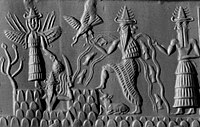Namtar
| Part of a series on |
| Ancient Mesopotamian religion |
|---|
 |
|
|
Namtar (or Namtaru, or Namtara; meaning destiny or fate), was a chthonic minor deity or demon in Mesopotamian mythology, god of death, and sukkal and messenger of An, Ereshkigal, and Nergal.[1]
Namtar was the son of Enlil and Ereshkigal; he was born before his father raped the goddess Ninlil. Namtar was considered responsible for diseases and pests. It was said that he commanded sixty diseases in the form of demons that could penetrate different parts of the human body; offerings to him were made to prevent those illnesses. It is thought that the Assyrians and Babylonians took this belief from the Sumerians after conquering them. To some they were the spirit of fate, and therefore of great importance. Apparently they executed the instructions given him concerning the fate of men, and could also have power over certain of the gods. In other writings they were regarded as the personification of death, much like the modern concept of the Grim Reaper.[2][3][4]
In the story of Ishtar's Descent to the underworld, acting as Ereshkigal's 'messenger', Namtar curses Ishtar with 60 diseases, naming five of the head, feet, side, eyes, and heart, after she arrives in the underworld.[5]
Namtar was regarded as the beloved son of Bêl/Enlil, and was married to the underworld goddess Hušbišag.
References[]
- ^ Gods, Demons and Symbols of Ancient Mesopotamia: An Illustrated Dictionary By Jeremy A. Black, Anthony Green, p 134
- ^ Mesopotamian religion and Ereshkigal under Encyclopædia Britannica
- ^ The Doctrine of Sin in the Babylonian Religion By Julian Morgenstern, Paul Tice p 18-19.
- ^ Myths of Babylonia and Assyria By Donald A. Mackenzie p.178
- ^ An Encyclopaedia of Religions by Maurice Arthur Canney p. 258
- Michael Jordan, Encyclopedia of Gods, Kyle Cathie Limited, 2002
- Descent of the Goddess Ishtar into the Lower World
- Mesopotamian gods
- Mesopotamian demons
- Health gods
- Death gods
- Mesopotamian underworld
- Deity stubs
- Middle East mythology stubs

